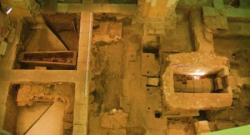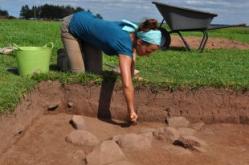- 28 AVRIL
- ITALIE – Ostie - Archaeologists say they have found the upper side of an ancient ship near Rome. The wooden ship was about 11 metres (36 feet) long, making it one of the largest ancient vessels excavated near Ostia Antica, a port city founded some 2,500 years ago and Rome's first colony. Ostia archaeology official Anna Maria Moretti said Thursday the discovery is important above all because it indicates the coastline during ancient Roman days was some 3-4 kilometres (2-2.5 miles) farther inland than it is now. The remains of the ship, missing its bow and stern, were found 4 metres (13 feet) underground during repairs of a bridge linking modern-day Ostia to Fiumicino, the town that hosts Rome's Leonardo da Vinci airport.
http://www.google.com/hostednews/canadianpress/article/ALeqM5hPl57b2MZdLRi7WRTXLXXvJiqqrA?docId=6696109
- USA – Abbott - The opening of the long-awaited motocross track at Abbott Sports Complex hit another snag with the discovery of animal bone fragments, a bison tooth and broken pottery at the site. The bones and artifacts may have been part of a Native hunting camp, so the site will be examined by the Nebraska State Historical Society's archaeological division The process could take as little as a few weeks or much longer, pending archaeological findings, according to Gayle Carlson, associate director for archaeology at the historical society. "There's not much left to the site," Carlson said. "Most of it has been destroyed by farming and everything that's happened. "We are interested in seeing if there's anything below the surface that has been preserved and is significant."
http://journalstar.com/news/local/article_0c98add7-399b-5d99-8228-fdb40e39f6bb.html
- FRANCE –  Souvigny - Du 19 juin au 13 novembre, le musée de Souvigny propose une rétrospective des différentes campagnes de fouilles archéologiques qui ont eu lieu durant un siècle. L’occasion de revivre l’essor providentiel de la cité clunisienne impulsé par Saint Mayeul et Saint Odilon, abbés. Élu grand site national en 1993, puis grand sanctuaire roman d’Auvergne, Souvigny a bénéficié d’importants travaux d’aménagement et de restauration de son patrimoine architectural qui ont permis aux scientifiques de mener des investigations archéologiques grâce à une série de sondages et de fouilles entre 1920 et 2011. Une place importante est consacrée à l’archéologie funéraire : tombeaux des saints abbés Mayeul et Odilon, du bâtard de Bourbon, ouvrant sur une étude anthropologique qui permet de connaître la réalité humaine de la population de Souvigny au cours des siècles. Les anciennes observations des chapelles des Bourbons seront reprises et confrontées à de nouvelles investigations. Parmi celles-ci, les premiers sondages en vue du dégagement de la peinture de la voûte de la Chapelle Vieille des Bourbons - qui viennent d’avoir lieu en janvier 2011- annoncent d’ores et déjà, de l’avis des instances scientifiques, une découverte majeure.
Souvigny - Du 19 juin au 13 novembre, le musée de Souvigny propose une rétrospective des différentes campagnes de fouilles archéologiques qui ont eu lieu durant un siècle. L’occasion de revivre l’essor providentiel de la cité clunisienne impulsé par Saint Mayeul et Saint Odilon, abbés. Élu grand site national en 1993, puis grand sanctuaire roman d’Auvergne, Souvigny a bénéficié d’importants travaux d’aménagement et de restauration de son patrimoine architectural qui ont permis aux scientifiques de mener des investigations archéologiques grâce à une série de sondages et de fouilles entre 1920 et 2011. Une place importante est consacrée à l’archéologie funéraire : tombeaux des saints abbés Mayeul et Odilon, du bâtard de Bourbon, ouvrant sur une étude anthropologique qui permet de connaître la réalité humaine de la population de Souvigny au cours des siècles. Les anciennes observations des chapelles des Bourbons seront reprises et confrontées à de nouvelles investigations. Parmi celles-ci, les premiers sondages en vue du dégagement de la peinture de la voûte de la Chapelle Vieille des Bourbons - qui viennent d’avoir lieu en janvier 2011- annoncent d’ores et déjà, de l’avis des instances scientifiques, une découverte majeure.
http://www.thewebconsulting.com/media/index.php?2011/04/28/19599-cent-ans-d-archeologie-a-souvigny-exposition
- CANADA –  Beaubassin - As it celebrates its 100th year as the world's first national parks service, Park Canada is again offering the public archaeology experience at the Beaubassin and Fort Lawrence national historic sites near the New Brunswick-Nova Scotia border. The program, led by archaeologist Charles Burke will run from mid-July until mid-August, running Thursday through Sunday each week.
Beaubassin - As it celebrates its 100th year as the world's first national parks service, Park Canada is again offering the public archaeology experience at the Beaubassin and Fort Lawrence national historic sites near the New Brunswick-Nova Scotia border. The program, led by archaeologist Charles Burke will run from mid-July until mid-August, running Thursday through Sunday each week.
http://www.amherstdaily.com/News/Local/2011-04-27/article-2459053/Busy-summer-ahead-at-Beaubassin,-Beausejour/1
- QATAR - Qatar Museums Authority will host the third GCC Archaeology Exhibition Heritage without Borders at the QMA Gallery (Katara) from May 2-June 30, 2011. The exhibition will demonstrate historical, cultural and geographical unity of the Gulf Co-operation Council (GCC) region. This unity is reflected in the history of the ancient Near East through the interaction with the neighbouring cultures and economic exchange. Nearly 420 objects from Saudi Arabia, Kuwait, UAE, Bahrain, Oman and Qatar will be displayed at the exhibition; some going back several millennia. Four major historical periods will be highlighted: Prehistoric Period: approximately 1mn years ago until 3rd millennium BC; the Dawn of Civilizations (cultures) Period: 3rd millennium to 3rd century BC; Pre-Islamic Periods: 3rd century BC to the 7th century AD and Islamic Period: 7th century until today.
http://www.gulftimes.com/site/topics/article.asp?cu_no=2&item_no=431182&version=1&template_id=36&parent_id=16
- CHYPRE - The Cyprus Archaeological Digitisation Programme (CADiP) started in mid-October 2009 in order to manage thousands antiquities scattered all over Cyprus “and serve the needs of the Antiquities department as well as those of researchers and the public,” Curator of Antiquities Despo Pilides yesterday said at a news conference. Roughly 1,300 monuments have been catalogued under the project. Also catalogued are Paphos Museum’s 5,000-odd artefacts found up until 1975. In order to get a complete picture on antiquities a lot of diverse information has to come together, she said. This would include photo archives, technical details including the excavation process, current location and preservation history. Some monuments and artefacts are on private land under the auspices of the Cyprus Museum and many others are in storage. A Geographic Information System, in essence a digital map of antiquities, will interface with all existing information on the catalogued antiquities making access and research much easier. In the future this will allow researchers to locate possible excavation sites by analysing existing data in order to predict the likelihood of the existence of an unknown archaeological site.
http://www.cyprus-mail.com/archaeology/digital-archive-cyprus-antiquities/20110428
- ROYAUME-UNI – Grandham - Archaeologists investigating at St Vincent’s in Grantham are hopeful they may find a long-rumoured underground operations room. Grantham Archaeology Group are looking into rumours of the underground site said to have been used by the top brass on the night of the Dambusters raid. Dave Hibbitt of GAG said: “We have been investigating several potential areas where the underground operations room was meant to be located and have now started to uncover what appears to be structures almost two metres deep underground.” The group has undertaken geophysical surveying to help locate buried features but it is too early to say if they are associated with the underground operations room. Mr Hibbbit said: “The evidence is stacking up.”
http://www.granthamjournal.co.uk/news/dambusters_dig_aims_to_find_operations_room_1_2631154